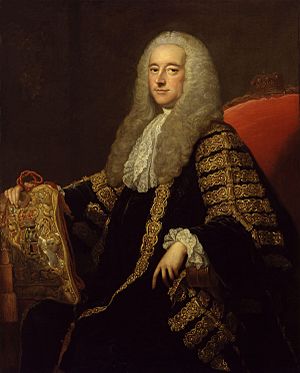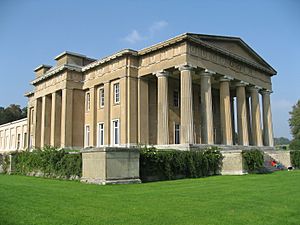Robert Henley, 1st Earl of Northington facts for kids
Quick facts for kids
The Earl of Northington
|
|
|---|---|

Portrait by Thomas Hudson
|
|
| Lord Keeper of the Great Seal Lord High Steward for the trial of: List
|
|
| In office 30 June 1757 – 16 January 1761 |
|
| Monarch | George II George III |
| Prime Minister | The Duke of Newcastle |
| Preceded by | In Commission |
| Succeeded by | himself as Lord High Chancellor |
| Lord High Chancellor of Great Britain Lord High Steward for the trial of: |
|
| In office 16 January 1761 – 30 July 1766 |
|
| Monarch | George III |
| Prime Minister | The Duke of Newcastle The Earl of Bute George Grenville The Marquess of Rockingham |
| Preceded by | himself as Lord Keeper |
| Succeeded by | The Earl Camden |
| Lord President of the Council | |
| In office 30 July 1766 – 22 December 1767 |
|
| Monarch | George III |
| Prime Minister | The Earl of Chatham |
| Preceded by | The Earl of Winchilsea and Nottingham |
| Succeeded by | The Earl Gower |
| Personal details | |
| Born | 1708 Hampshire |
| Died | 14 January 1772 (aged 63–64) Hampshire |
| Nationality | English |
| Political party | Whig Party |
| Spouse | Jane Huband |
| Children | 8 |
| Parent | Anthony Henley |
Robert Henley, 1st Earl of Northington (born around 1708, died January 14, 1772), was a very important person in British law and government. He held the top legal job as the Lord High Chancellor of Great Britain. He was also a member of the Whig Party, a major political group at the time. People knew him for being clever and a good writer.
Contents
Who Was Robert Henley?
Robert Henley came from a rich family in Hampshire, England. He was the second son of Anthony Henley. His family had a history of working in law. His grandfather, Sir Robert Henley, was a respected lawyer.
Robert's Family Background
Robert's father, Anthony Henley, went to Oxford University. He loved books and writing. When he moved to London, he became friends with many famous writers and important people. Anthony Henley was also a Member of Parliament for Andover in 1698. He passed away in 1711. Robert later took over the family's property after his older brother.
Robert Henley's Early Life and Education
Robert Henley went to Westminster School, a famous school in London. After that, he studied at St. John's College in Oxford. In 1727, he earned a special position at All Souls College. He then started studying law in 1729 and became a lawyer on June 23, 1732.
In 1746, Robert inherited The Grange, Northington in Hampshire from his older brother. This grand house was built by the famous architect Inigo Jones for his grandfather.
What Important Jobs Did Robert Henley Have?
Robert Henley had a very successful career in law and politics. He held several high-ranking positions in the British government.
Becoming a Member of Parliament
In 1747, Robert Henley was chosen to be a Member of Parliament for the town of Bath. This meant he helped make laws for the country. In 1751, he also became the Recorder of Bath, which was a legal role for the town.
Rising Through the Legal Ranks
In 1756, he became the Attorney General, a chief legal advisor to the government, and was made a knight. The next year, in 1757, he was promoted to Lord Keeper of the Great Seal. He was the last person to hold this specific title.
Even though he was in charge of the House of Lords as Lord Keeper, he didn't become a noble until 1760. That's when he became Baron Henley of Grange.
Becoming Lord Chancellor
When George III became king, Robert Henley was given an even more important job. In 1761, he was named Lord High Chancellor of Great Britain. This is one of the highest legal positions in the country. In 1764, he was given an even higher noble title, becoming Earl of Northington.
King George II had not wanted to make him a noble earlier. This was because Henley had supported the Prince of Wales, who was King George II's son. However, in 1760, Henley needed to lead a special trial as Lord High Steward. Because of this, he finally received his noble title.
Robert Henley left his government job in 1767. He passed away at his home in Hampshire on January 14, 1772.
Robert Henley's Family Life
In 1743, Robert Henley married Jane Huband. She was the daughter of Sir John Huband from Warwickshire. They had a large family with three sons and five daughters.
Robert Henley's Children
His daughters were:
- Lady Catherine Henley (died January 9, 1779)
- Lady Bridget Henley (died March 13, 1796)
- Jane Henley (died February 1823)
- Lady Elizabeth Henley (died August 20, 1821)
- Mary Henley (1753–1814)
His son, Robert Henley, 2nd Earl of Northington, took over his title after his death.
Important Legal Cases
As Lord Chancellor, Robert Henley was involved in many important legal cases. Here are a few examples of the ideas he supported:
- Vernon v Bethell (1762): He believed that people who are in great need are not truly free. They might agree to unfair terms just to solve an urgent problem.
- Shanley v Harvey (1763): He famously stated that "as soon as a man sets foot on English ground he is free." This was a very important idea about freedom.
- Brown v Peck (1758): He ruled that parts of a will that tried to stop people from living together were against public policy. For example, if a will offered more money to someone if they separated from their husband, he said they should still get the higher amount.
- Pike v Hoare (1765): He stated that a will about land in the Colonies could not be tried in England. This was about which country's laws applied.



